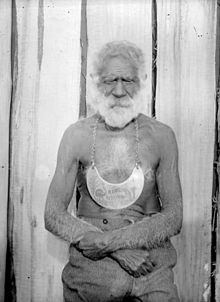- Yuin people
-
Yuin people Aka: Thurga (Tindale)
Dhawa (AIATSIS), Dhu Dhurga (SIL)
South East Corner BioRegionHierarchy Language Family: Pama–Nyungan Language Branch: Yuin–Kuric Language Group: Yuin
(shared word for man)
(aka Thurga)
(shared word for no)Group Dialects: Djiringanj (Tindale)
Thaua(Tindale)
Walbanga(Tindale)
Wandandian(Tindale)Area BioRegion: South East Corner Location: South Coast (NSW) Coordinates: 36°30′S 149°45′E / 36.5°S 149.75°ECoordinates: 36°30′S 149°45′E / 36.5°S 149.75°E Notable Individuals Guboo Ted Thomas Yuin people (aka Thurga) are those Australian Aborigines from the South Coast of New South wales who are considered to be the traditional owners of the land and water from Merimbula to Port Jackson.[1]
Contents
Country
All Yuin people share in common, ancestors who spoke as their first preferred language, one or more of the Yuin language dialects, including Djiringanj, Thaua, Walbanga, or Wandandian.
The country the Yuin ancestors occupied, used, and enjoyed reached across from Cape Howe to the Shoalhaven River and inland to the Great Dividing Range.
Two of the Yuin groups include:[1][2]
- Walbanga, north of present day, Narooma
- Dyiringanj, or Djiringanj, from Narooma, south to Bega and west to the top of the range.
History
The population before 1788 has been estimated at about 11 000 between Cape Howe and Batemans Bay. The population was reduced to only 600 by the mid nineteenth century due to smallpox epidemics in 1789 and 1830, as well as tribal battles and the spread of venereal disease from whalers.[1]
The Eurobodalla Shire Council signed a Local Agreement with the Yuin people in 1998. In 2001, a Memorandum of Understanding was signed between the Bega, Eden and Merrimans Local Aboriginal Land Councils, the Native Title Holders and the Bega Valley Shire Council. [3]
Places
The Yuin are considered as the traditional owners of Wallaga Lake land.[1] The former Wallaga Lake National Park is incorporated into Gulaga National Park.[4]
Merriman Island in Wallaga Lake is a sacred place for the Yuin people. On 25 November 1977, it was the first place in New South Wales to be declared an Aboriginal Heritage site by the New South Wales National Parks and Wildlife Service (NPWS). The island was named after King Merriman, leader of the Yuin, who died in 1904. His Aboriginal name was Umbarra. His wife was Queen Narelle.
Mumbulla Mountain, located in the middle of Bega Valley Shire, was named in November 1973, after Jack Mumbulla, who was a senior man of the Yuin people.[5] Mumbulla Mountain is the central place of significance in Biamanga National Park. Certain areas have been recognised as a ceremonial meeting places for Aboriginal men and women.[6]
Mount Dromedary, recently renamed Gulaga Mountain, in the Gulaga National Park, is described by Aboriginal people as the place of ancestral origin for Yuin people. Gulaga itself symbolises the mother and provides a basis for Aboriginal spiritual identity, for Aboriginal women and men.[6]
On 6 May 2006 the freehold titles to Gulaga and Biamanga National Parks were handed back to the Yuin people by the New South Wales Government. Freehold title of Gulaga National Park will be held in trust for the aboriginal owners by Merrimans and Wagonga Local Aboriginal Lands Councils, while that of Biamanga will be held in trust by Merrimans and Bega Local Aboriginal Lands Councils.[7]
Montague Island is known to the Yuin people as Barranguba. Barranguba is regarded as being the son of Gulaga, along with Najanuga; Barranguba being the oldest son and allowed out to sea, whereas Najanuga had to stay close to his mother.[8]
Alternative names
The Yuin are also known as: Yuwin, Djiringanj, Dyirringan, Jeringin or Juwin.
References
- ^ a b c d "The Aboriginal Peoples – The Yuin Tribes". Taken from the book "Bermagui – A Century of Features and Families" by Ron Gaha and Judy Hearn. Internet Archive cached version from March 10, 2005 of The Mumballa Foundation web site. 2004. Archived from the original on 2005-03-10. http://web.archive.org/web/20050310170711/http://www.mumbulla.org/html/yuin_peoples.html. Retrieved 2006-05-22.
- ^ Luff, Erika (2005). "Aboriginal Overview". Cultural map. Bega Valley Shire Council. http://www.begavalley.nsw.gov.au/Cultural%20Map/aboriginal/aboriginal.htm. Retrieved 2006-05-22.
- ^ Mazel, Odette (2005). "Yuin Nation – Agreements". Agreements, Treaties and Negotiated Settlements Project – Agreements Database. University of Melbourne. Archived from the original on 2006-02-11. http://web.archive.org/web/20060211001938/http://www.atns.net.au/biogs/A000871b.htm. Retrieved 2006-05-22.
- ^ "Gulaga National Park". New South Wales National Parks and Wildlife Service. New South Wales Department of Environment and Climate Change. 2006. http://www.nationalparks.nsw.gov.au/parks.nsf/parkContent/N0165?OpenDocument&ParkKey=N0165&Type=xo. Retrieved 2006-05-22.
- ^ "Mumballa Foundation". Internet Archive cached version from March 10, 2005 of The Mumballa Foundation web site. 2004. Archived from the original on 2005-03-10. http://web.archive.org/web/20050310091753/http://www.mumbulla.org/. Retrieved 2006-05-22.
- ^ a b NSW Minister for the Environment, Debus, Bob (2006). "Formal handback of Biamanga and Gulaga national parks to Aboriginal community: Media release – Friday, 3 February 2006". Media releases. New South Wales Department of Environment and Climate Change. http://www.nationalparks.nsw.gov.au/npws.nsf/Content/dec_media_min_060203_01. Retrieved 2006-05-22.
- ^ Pacey, Laurelle (11 May 2006). "Handing back heartbeat of Yuin nation". Narooma News. http://narooma.yourguide.com.au/detail.asp?class=news&subclass=local&story_id=479434&category=General%20News&m=5&y=2006. Retrieved 2006-05-22.[dead link]
- ^ Foster, Warren (2006). "Gulaga told by Warren Foster". Stories of the Dreaming. Australian Museum. http://www.dreamtime.net.au/gulaga/text.htm. Retrieved 2006-05-22.
External links
- AusAnthrop Australian Aboriginal tribal database entry for Thaua (aka Thurga, aka Yuin) Accessed 9 June 2008
- Tindale, Norman (1974) "Djiringanj" (dialect of Yuin) in his Catalogue of Australian Aboriginal Tribes. South Australian Museum. Accessed 9 2008
- Portion of Norman Tindale's (1974) Tribal Boundary Map including Djiringanj, Thaua, Walbanga, & Wandandian Accessed from South Australian Museum website 9 June 2008
Categories:- Aboriginal tribes of New South Wales
- Yuin-Kuric languages
- South Coast, New South Wales
- Extinct languages of Australia
Wikimedia Foundation. 2010.

